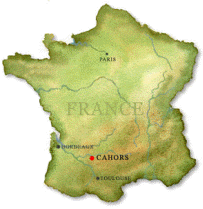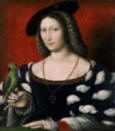Biography
Some biographical highlights
 Clément Marot was born in
Cahors (probably in 1496 and perhaps on 23rd of November (because the
patron saint of that day is Clemens)); he died in Turin on 12
September 1544 and was buried in the crypt of the Turin Cathedral.
Clément Marot was born in
Cahors (probably in 1496 and perhaps on 23rd of November (because the
patron saint of that day is Clemens)); he died in Turin on 12
September 1544 and was buried in the crypt of the Turin Cathedral.
LIFE
Son of the court poet Jean Marot Clément tried to
follow in the footsteps of his father. Although he always refers to
his place of birth (Clément Marot de Cahors en Quercy), he probably
did not live there very long. Already in 1518 (just over 20 years
young) he succeeded in getting a post as secretaire at the  court of Marguerite of
Navarre, sister of Francis I, King of France. This court was a center
of culture and in the 1520s became the hotbed of ecclesial reform. She
corresponded intensely with the Bishop of Meaux, who in his diocese
was organizing one of the most promising experiments of church renewal
(Meaux = just north of Paris). She was the sponsor and certainly the
protector, if not background coordinator. Her personal scholar, the
par of Erasmus, Lefèvre d'Etaples, supervised the
experiment. Next to this she was quite a learned woman and a
gifted poet (and posthumous: storyteller and playwright). Marot's
religious inspired poetry, like his first Psalm versification and
simple prayers in French have their natural habitat in her sphere. His
first Psalm (nr. 6) was added to a reprint of Marguerite's Miroir de
l'âme pécheresse, 1533) and the prayers appeared in a closely annexed
pamphlet about the reform of orthography.
court of Marguerite of
Navarre, sister of Francis I, King of France. This court was a center
of culture and in the 1520s became the hotbed of ecclesial reform. She
corresponded intensely with the Bishop of Meaux, who in his diocese
was organizing one of the most promising experiments of church renewal
(Meaux = just north of Paris). She was the sponsor and certainly the
protector, if not background coordinator. Her personal scholar, the
par of Erasmus, Lefèvre d'Etaples, supervised the
experiment. Next to this she was quite a learned woman and a
gifted poet (and posthumous: storyteller and playwright). Marot's
religious inspired poetry, like his first Psalm versification and
simple prayers in French have their natural habitat in her sphere. His
first Psalm (nr. 6) was added to a reprint of Marguerite's Miroir de
l'âme pécheresse, 1533) and the prayers appeared in a closely annexed
pamphlet about the reform of orthography.
In 1527 Marot had become valet de chambre du roi (court poet, a
honorary function) and his fame increased. All of Paris was
familiar with him through some of his poems that circulated and
occasionally were printed. A huge success he scored with his chansons,
published by Attaingnant. In 1534 he had to leave the country because
of the Affaire des placards: fierce broadsheets against the 'popish
Mass' were hung everywhere in and around Paris and anyone suspected of
sympathies for "Lutheranism", as it is then called, was in acute
danger. After finding shelter in Navarre (with... Marguerite, now
married to king of Navarre) he traveled to Ferrara, where the
half-sister of the king, Renée de France, held court, not only
entertaining the French in Italy, but at the same time actively
stimulating intellectual, moral and ecclesial renewal. After two years
of exile Marot could only return to France because he publicly abjured
his 'errors' and explicitly confirmed his allegiance to the Roman
Catholic Church (December 1536, in Lyon). He was restored to his
position and became the greatest poet of his time. From then on he
kept silent about his innermost convictions. But his name stayed
connected to the Reform movement, his Psalm versifications circulated
in manuscript, and became associated with Calvinism ever since John
Calvin used 13 of them in his first Hymnbook (Strasbourg, 1539). In
1542 a new wave of prosecutions made him decide to leave France. He
departed for Geneva this time, where he was well received by Calvin,
who actively supported him while he was expanding his versification of
the Psalter. Marot left the city late 1543, wanting to return to
France. He died on 12 September 1544, at the age of 47, in Turin where
the French troops had their headquarters. At his death, an epigram
was carved out in marble and placed in the Turin Cathedral,
where it was removed thirty years later on the explicit command of the
Bishop of Turin.
WORKS
As was normal procedure in those days poems
circulated in manuscript, and only poems made for special occasions
were printed. The texts of his songs (chansons) appeared in music
editions (music Claudin de Sermisy, Clement Janequin, both court
musicians; editor: Pierre Attaingnant. Precisely because of the
enormous popularity Marot felt compelled to publish an anthology of
his poems, both to differentiate between authentic and unauthentic
texts and to provide correct (or improved) versions. He named this
anthology: "Clément's youth", Adolescence Clementine (1532,
preface 1530). In this compilation he gathered the harvest of his
first 30 years as a poet. Many old art forms (ballads, rondeaux) are
present, but also new types can be found such as the chanson (new as
an art-form). Also characteristic is the presence of translations (or
imitations, re-creations) of the classical poets (Virgil, Horace,
Ovid). Here Humanist influence can be surmised. Marot proved to
be well versed in epistolary art, giving this classical form a very
personal touch. Famous is his épistre au roy pour le delivrer du
Prison (1527) and his au roy pour avoir été derobe (1532). During his
exile he perfected this art form, with as a summit of his ability the
épistre au roy, du temps de son exil � Ferrare (1535), in which he
begs to be allowed to return from exile. Before he had to
flee he had published La Suite de l'Adolescence Clementine, in which
he brought together more poetry from his first period. Also a
series of translations of Ovid's Metamorphoses appeared in print
around the same time, as always 'dedicated to the King'. When Marot
returned from exile he published a new version of his Works (also
suppressing some of the more religiously risky poetry) in 1538,
Oeuvres. Marot is often regarded as the poet who concluded the Middle
Ages (Rhetoriqueurs) and ushered in a new era: the French
Renaissance. In later years he specialized in epigrams - like
Martial -. While still in exile, he reinvented the old genre of the
blason challenging his fellow poets to describe a (small) part of the
female body in the most charming way. His own Blason du beau Tetin was
the example to follow. The combination of craftsmanship in writing and
a witty mind made him the 'prince of the French poets of his days',
loved and admired by many, feared by others. As a satirist he finished
off his arch-enemy Sagon with the l'épitre de Frippelippes
(1537). His contemporary poems in which the text of the Hebrew
psalms was reformulated in 16th century strophic form, made him a name
in scholarly and religious circles. He translated ap�s la v�rit�
Hebraicque, i.e. based on the original language (albeit via
translations). This in itself purely Humanist idea (ad fontes,
back to the sources) applied to the poetry of the Psalter became an
unexpected hit in evangelical circles. The poems, initially made
for private use (the Court), circulated in Reform oriented
circles. In 1539 John Calvin gathered a good dozen of them and he
had them set to music (melody) together with some of his own (and
others?) exercises. This publication (Aulcuns Psaulmes,
Strasbourg 1539) was the beginning of the habit of singing psalms in
the reformed liturgy. In 1541 Marot himself published a first
collection (Trente Psaumes) and in 1543 the definitive collection:
Cinquante Psaumes (Geneva/Paris). In Geneva, Lausanne and Lyon
composers could not wait to compose music (either like a motet, or
like a chanson) to these texts. The Cinquante Psaumes (49 Psalms and
the Canticle of Simeon) plus some other texts became the core of the
Huguenot Psalter.
APPRECIATION
The new generation of French poets around
the middle of the 16th century (the young wolves of the Pléiade like
Ronsard, De Baïf etc.)) dismissed Marot's poetry as old-fashioned,
mainly - of course - to promote themselves as the
alternative. This criticism gave Marots poetry a bad name for
centuries. Only in the late 20th century a revaluation of the Prince
des Poètes françaises took place. He is now considered to be the first
Renaissance poet in French literature and - based on his preference
for translations - also as a Humanist who wanted to offer the texts of
classical and biblical antiquity to the modern reader in his mother's
tongue.
a
table with a chronology of Marot's life, works and main events (in
Dutch)
References
Edition:
Clément Marot, Oeuvres Poétiques, two volumes,
Ed. G. Defaux, Classiques Garnier, 1990/1993
Biography:
C.A. Mayer, Clément Marot, Paris 1972 (the introduction of the
abovementioned edition can be used as an update and in some parts a
counter-balance)
